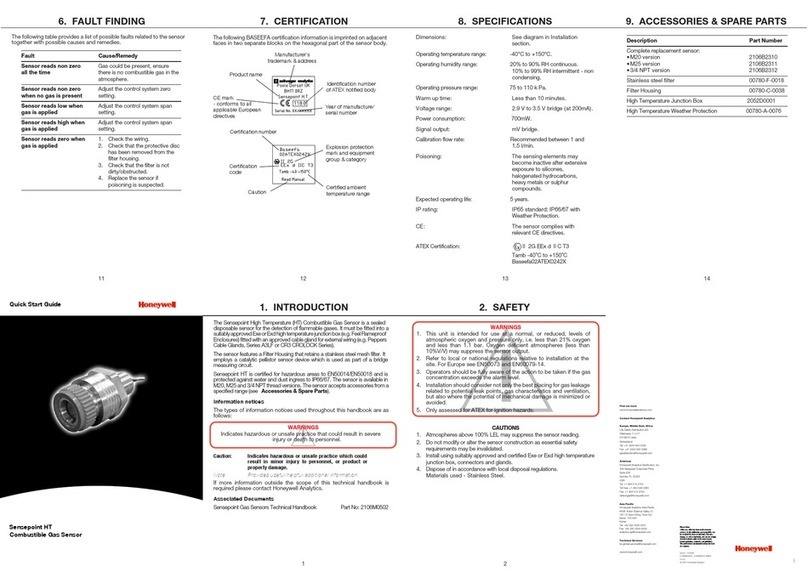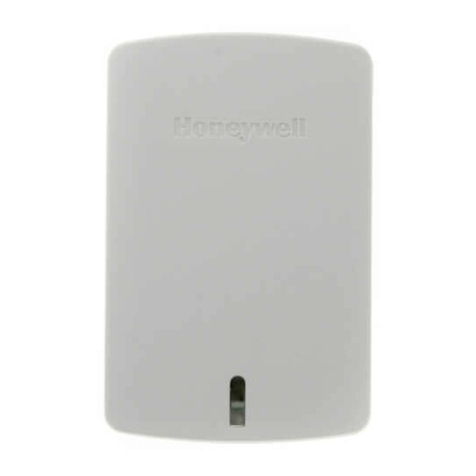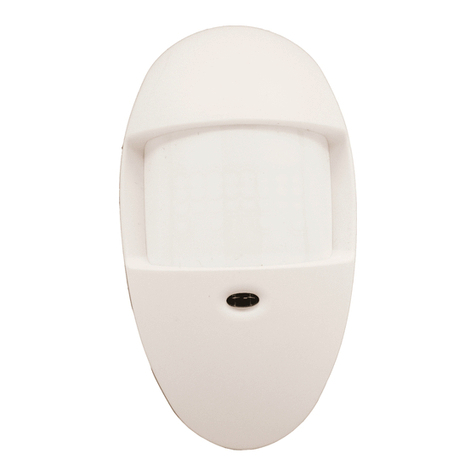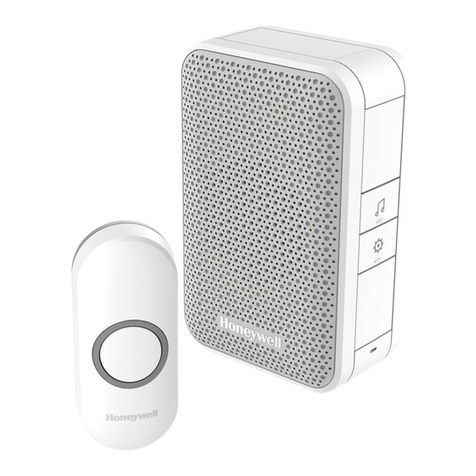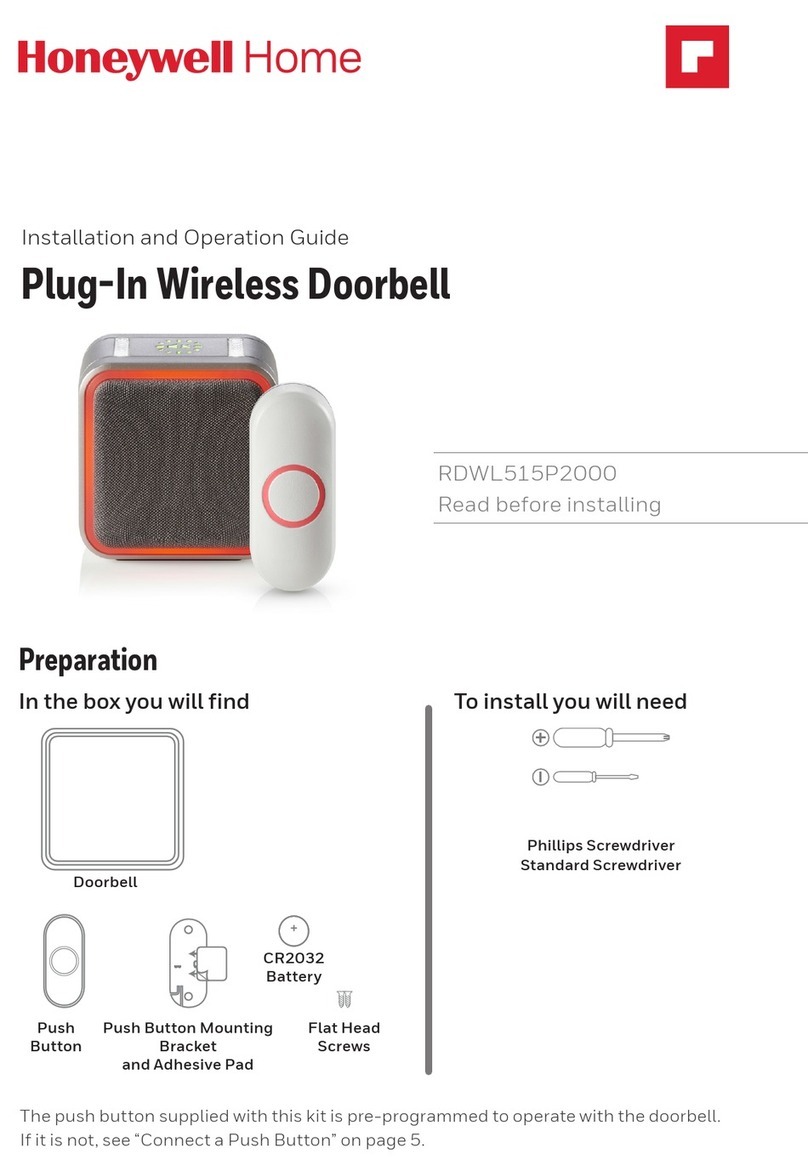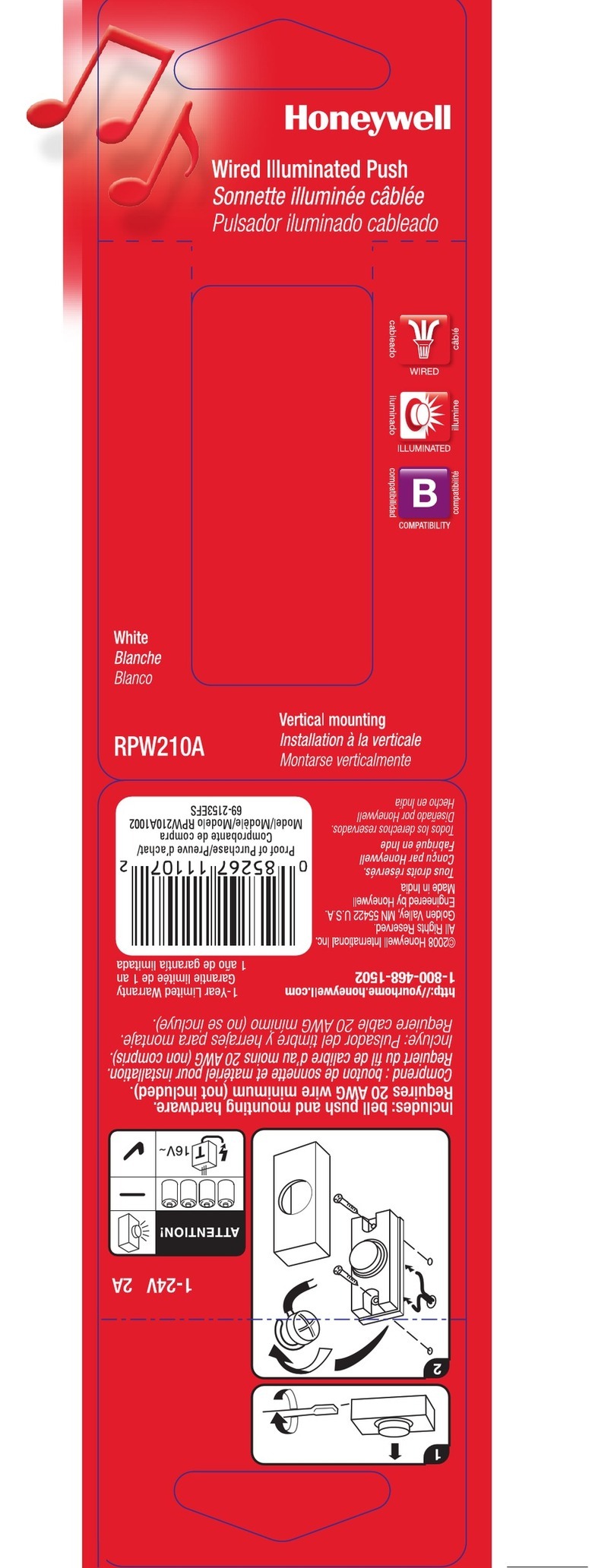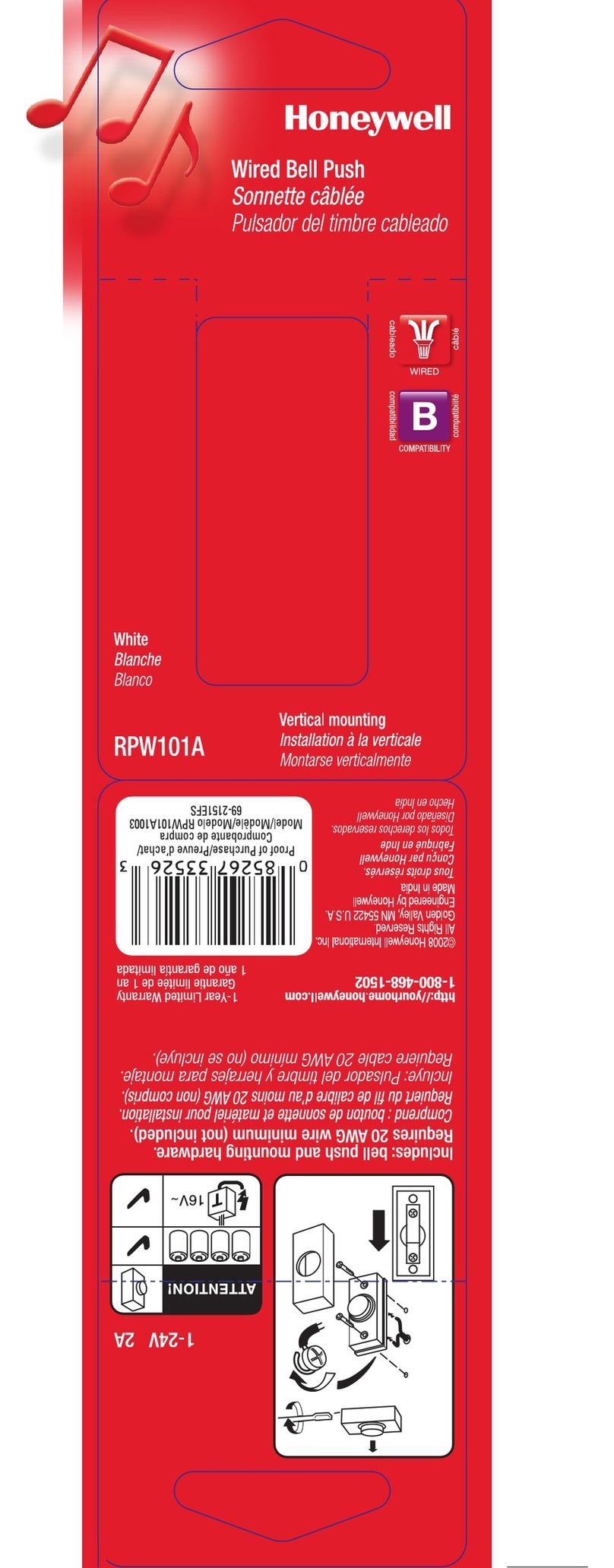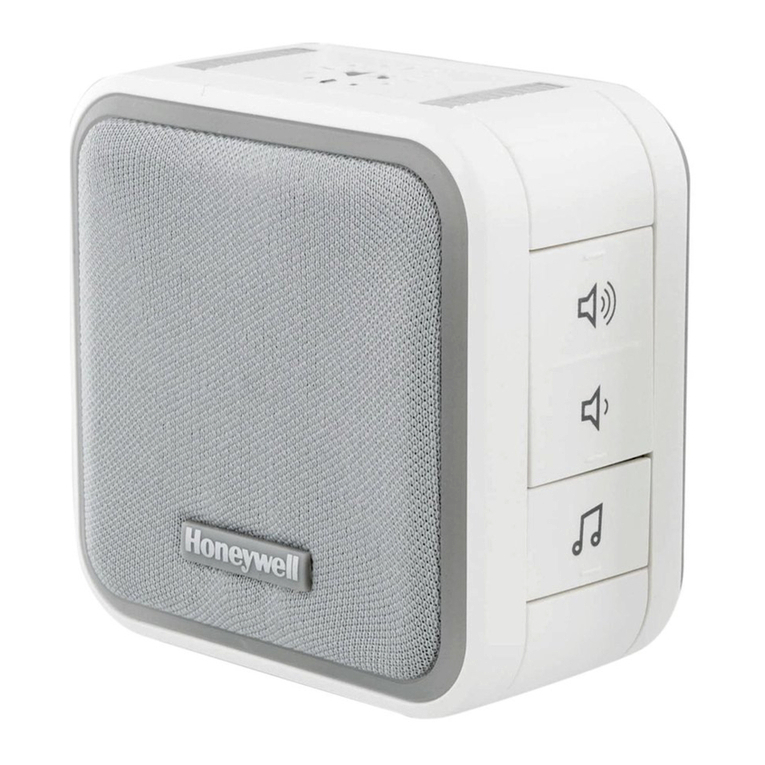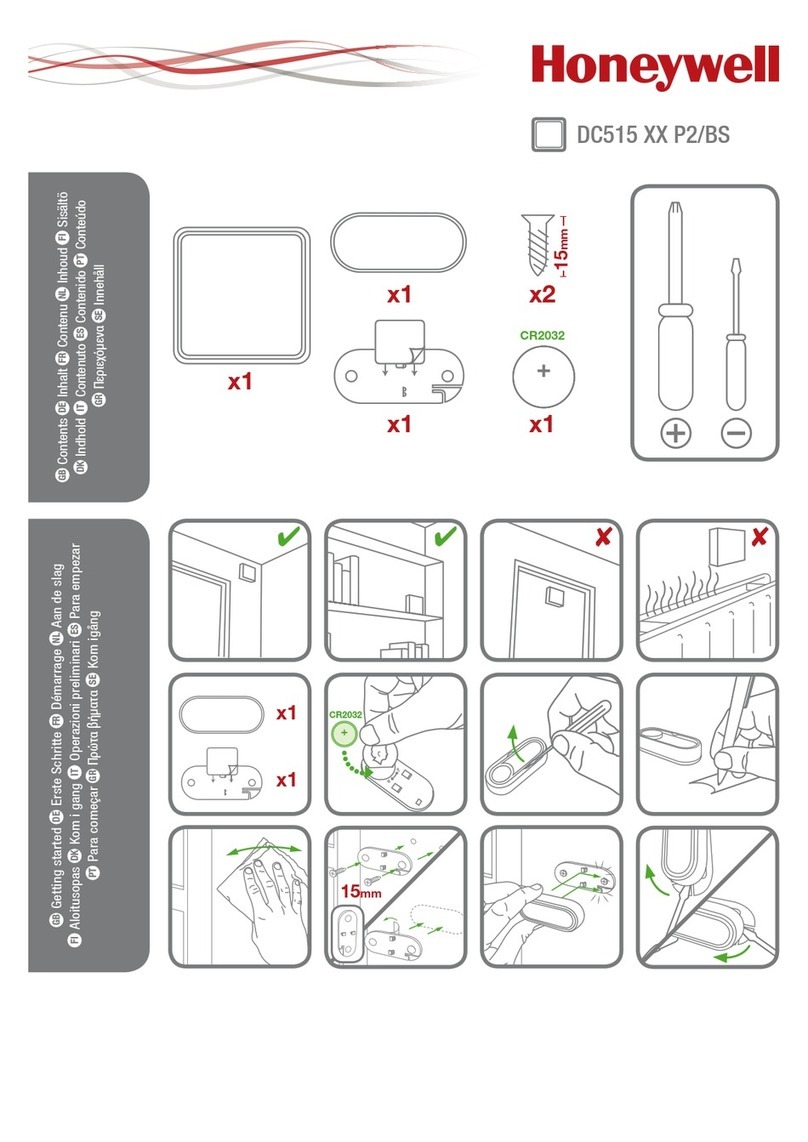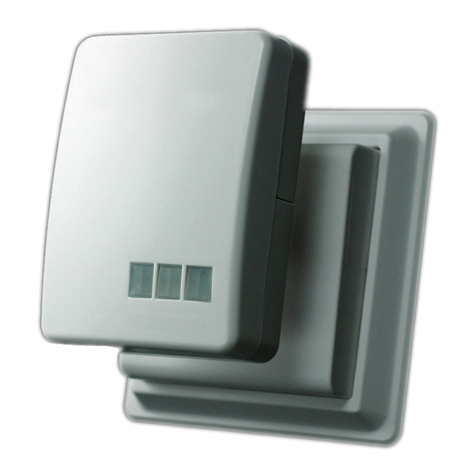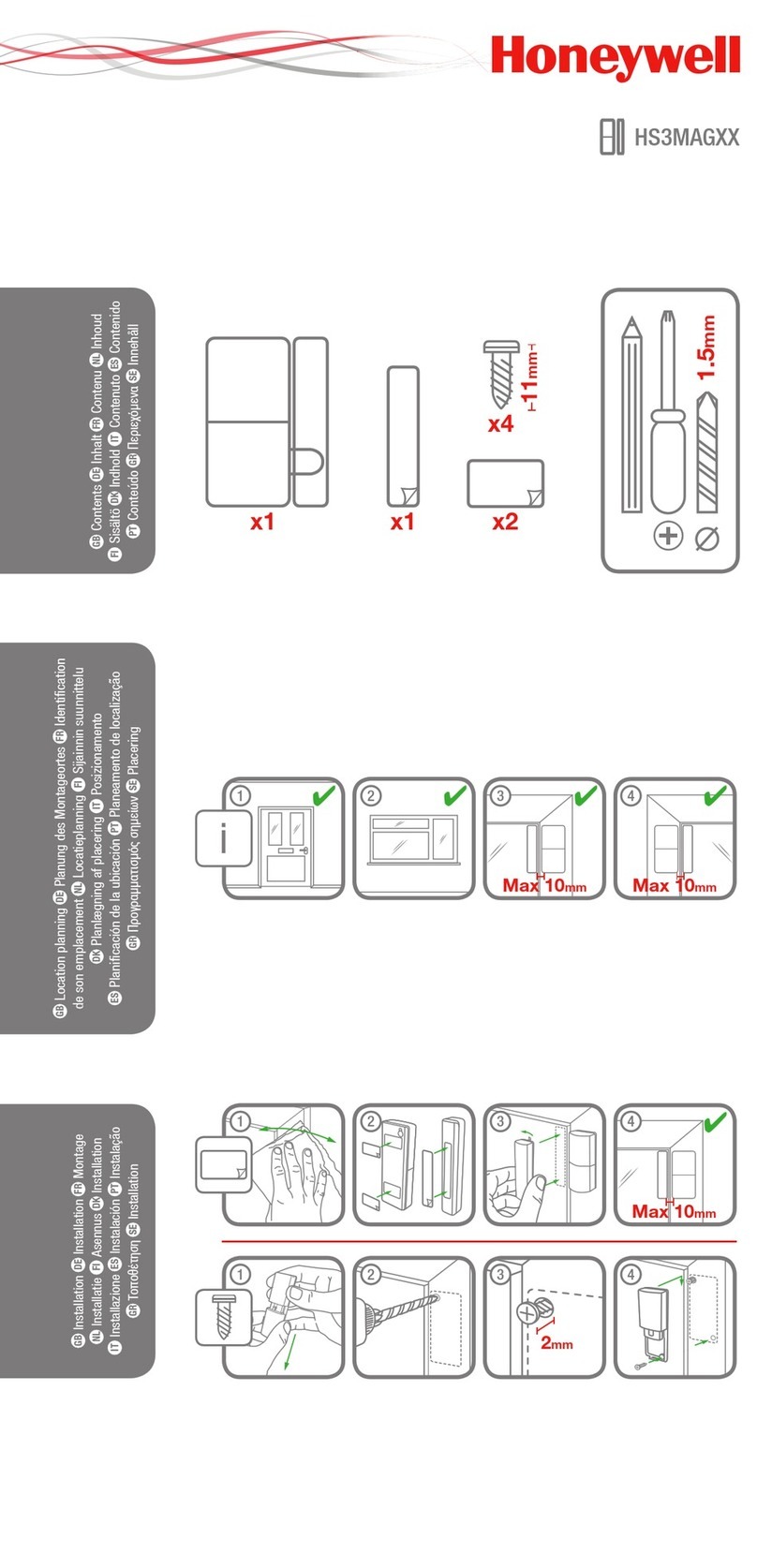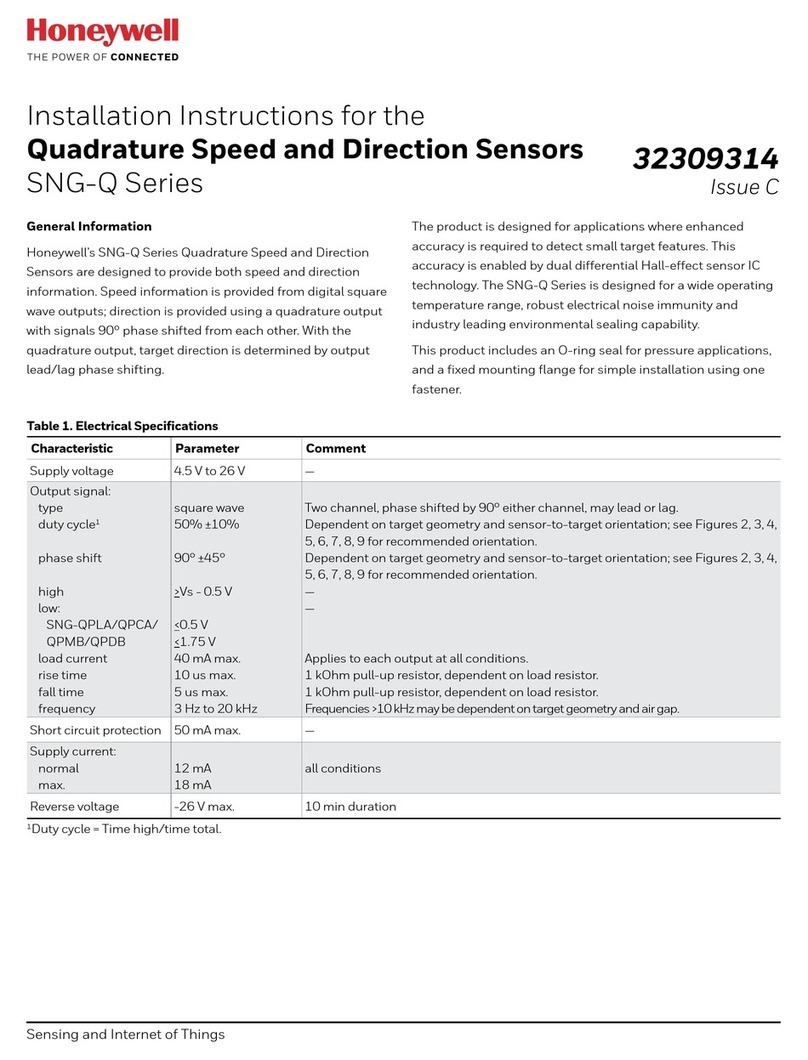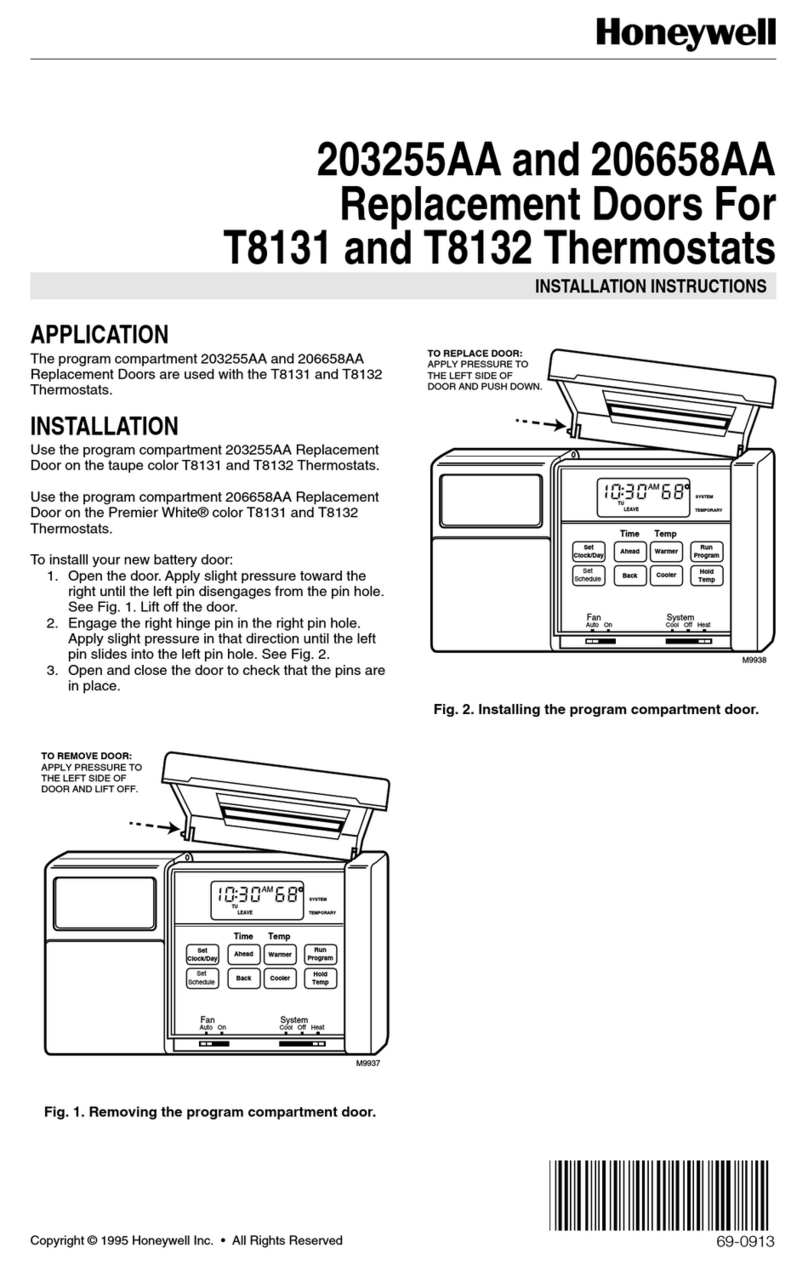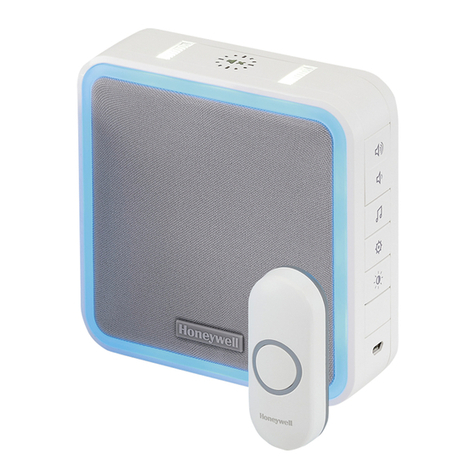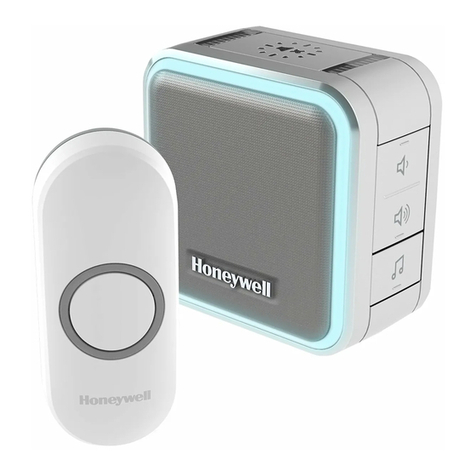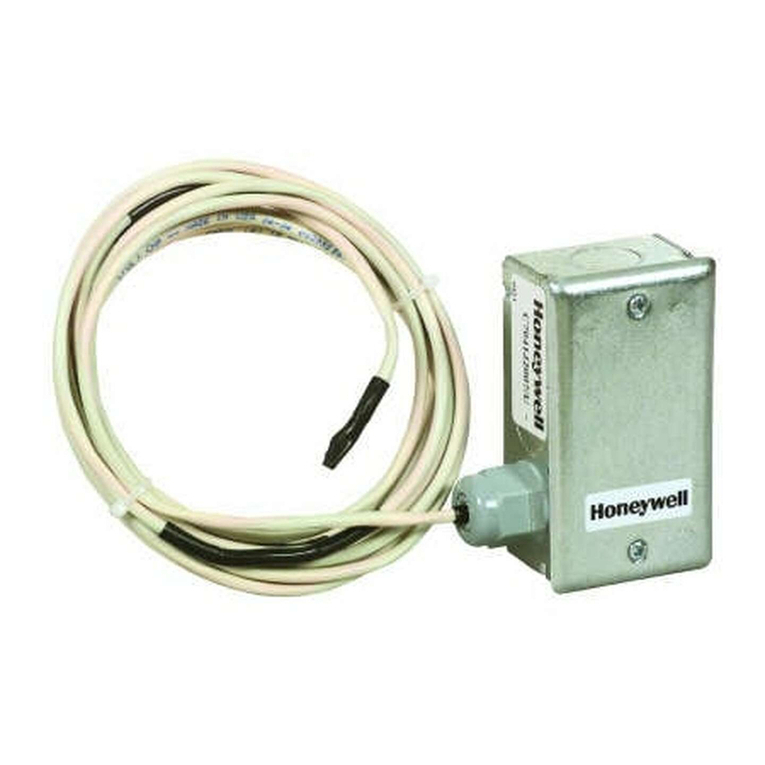Condition of LEDs
with No Motion
PIR
A
LARM MW
(Green) (Red) (Yellow)
Reaction of LEDs
to Walk-Test
PIR ALARM MW
(Green) (Red) (Yellow)
Type of Possible
Problem Causes
(Pattern disappears)
MWenvironmentalproblem
IMBALANCE MW rangetoo long
PIRwasblocked
RATIO
IMBALANCE
PIRrangetooshort
PIRaimedwrong
PIRnotreporting
(Patterndisappears)
RATIO
IMBALANCE
PIR environmental problem
PIR unstable
MW range too short
RATIO MW range too short
IMBALANCE MW not reporting
OperatingMode
Alert
Local Test
Standby
Remote Test
Walk Test LED's
Disabled Enabled Disabled Disabled
MicrowaveOscillator On On
Off
On
Alarm Outputs Enabled Enabled
Frozen
Enabled
Alarm Memory Activated
Yes
No No
Yes
Alarm Memory Reset
OnlywhenEntering No No No
Alarm Memory Displayed
(Red LED flashing)
Disabled Enabled Enabled Disabled
Trouble Disabled Enabled Enabled Disabled
DT·900 Series DUAL TEC® Motion Sensor Supplemental Information
MOUNTING LOCATION DT-906 DT-900
Aimthesensortowardtheinterioroftheroom,awayfromwindows,movingmachinery,andheating/
cooling sources.
Makesurethesensorhasaclearline-of-sighttoallareasyouwishtoprotect.IfthePIRisblocked,the
unit will not alarm.
TAMPER
The sensor covers and wall mounting are tamper protected. A screw mustbe installed in the wall
to utilize the tamper feature.
WIRING
Reverse polarity will not damage the sensor
.
Knockouts are provided to allow wire entry via 1/2" EMT or surface wiring conduit.
NOTE: For proper wiring methods, refer to the National Electrical Code NFPA 70.
INFORMER MODE
The INFORMER circuit counts the number of events registered by both the microwave and PIR
technologies, and uses the resulting ratio to determine if either technology is working properly or is
misapplied. Establish the INFORMER mode using switch S2. (See Step 7.)
Mode 1: Set S2 to position 1. In Mode 1, 32 PIR events without a microwave event will cause the
unittogointoPIRINFORMER. 128microwaveeventswithoutaPIReventwillcausetheunit togo
intomicrowaveINFORMER. OneLEDindicationdoesnotrelatetoonePIRevent.
Mode 2: Set S2 to position 2. In Mode 2, 16 PIR events without a microwave event will cause the
unittogointoPIRINFORMER. 16microwaveevents withoutaPIReventwillcausetheunit togo
into microwave INFORMER. One LED indication does not relate to one microwave event.
NOTE: TheMode2settingisnot recommended. UseonlyiffastINFORMER activation
is required.
Trouble Memory
Disabled: To disable INFORMER function, set S2 to the open position. IftheLEDpatterndisappearsbeforeyouseeit,youcanretrievethepattern.The troublememoryfeaturestoresthelastLEDpatternfrom
a self-test detected problem or an INFORMER condition.
WhenanINFORMERconditionoccurs,thetroublerelayopens,andtheLEDsdisplayanINFORMERtroublecode.Thesensorperforms
a self-test within the hour to determine if the problem is internal. TorecovertheLEDpattern,firstopentheTopCover(seeStep2). Usingasmallscrewdriver,momentarilyshort circuitthetwoSelf-Test
pads located on the printed circuit board (see Supplemental Information, Figure 1). The trouble LED pattern will be re-displayed.
If a self-test error is detected, the self-test LED pattern, all three LEDs flashing, replaces the INFORMER LED pattern. Short the pads with the screwdriver again to clearthe LED patternand initiate a self-test.
If no self-test error occurs, the unit continues to display the INFORMER LED pattern and relay remains open. The problem is
misapplication. Walk-test the sensor to pinpoint the cause. (Referto Troubleshooting Table 3.) Anti-Mask
The DT-900Series anti-mask feature detects attempts to block or cover the sensor by sending an active infrared beam out into the
INPUT MODES sensor's field-of-view,at regular 8 second intervals. If the DT-900/DT-906 is blocked orcovered (i.e. with a box or fabric) the beam
The DT-900 Series accommodates several international operating requirements using two operating modes-Standardmode with is reflected back to the sensor. After two consecutive reflected beams, the sensor signals a trouble condition-green and red
remote LED enable and Command Input capability or European 2-Wire CENELEC mode (INPUT 1 and INPUT 2). For Standard LEDsflash rapidly and the mask relay opens.
Mode, remove jumperJ4 and installjumper J6. For CENELEC mode, remove jumper J6 (See Figure 1).
INFORMER Conditions
Table 1 Standard Mode-J6 Installed Table 2 CENELEC Mode-J6 Removed
Table3describestwotroublealertswhicharereportedbytheINFORMERcircuit. Tousethistroubleshootingmatrix:
1)
Find the trouble alert that describes the condition of the walk-test LEDs (with no motion in the area).
2)
Walk-test the sensor, carefully watching the reaction of the diagnostic LEDs.
3)
Refer to the Possible Causes column of the matrix for an explanation of the way in which the diagnostic LEDs
reacted to the walk-test.
Table 3 INFORMER
Troubleshooting Matrix
Table 4 Cenelec Functions
RATIO
TROUBLESHOOTING
VerticalAdjustment
Variousmountinglocationsmayrequirefineverticaladjustment(e.g.unevenwallsor floors,etc.). Duringthewalk-test,ifthePIRisshort-
ranged, turn the Vertical Adjust Screw counterclockwise. If the PIR is over-ranged, turn the Vertical Adjust Screw clockwise.
(See Step 5.)
Self-Test
The sensor microcontroller automatically performs aseries of self-tests inthe following instances:When theunit ispowered up, when
tests areinstaller initiated, uponCommand Input,or everyhour duringnormaloperation. A self-test errorcauses theTrouble relay
to openandall3LEDs flashuntilthe problemiscorrected. IftheproblempersistsandtheLEDs continuetoflash, theunitisdefective LED Legend: = LED is Flashing Slow =LED is OFF
and must be returned fo
air.
DETECTIONPATTERNS
Patternsfor: DT-900
Patterns for: DT-900
Pattern for: DT-906 TOP VIEW 27 m (90') Range 15 m (50') Range
61 m (200') Range Barrier Lens-All Zones TOP VIEW
TOP VIEW
Wide Angle Lens WideAngle Lens
SIDE VIEW
BarrierLens-All Zones
Pattern for: DT-906
TOP VIEW
37 m (120') Range Barrier Lens-All Zones
IndicatesDetectionArea
SIDE VIEW
Barrier Lens-All Zones SIDE VIEW SIDE VIEW
Wide Angle Lens WideAngle Lens
PRODUCT SPECIFICATIONS IMPORTANT: DT-900 Series sensors should be tested at least once each year to ensure proper operation.
Range:
DT-906
37 m x 3 m / 61 m x 5 m
120' x 10' / 200' x 15'
DT-900
15 m x 12 m / 27 m x 21 m
50' x 40' / 90' x 70'
Alarm relay:
Energized Form C; 25 VDC, 125 mA
22 ohm series protection resistor
Power requirements:
10 - 15 VDC; 50 mA (max) at 12 VDC
AC Ripple: 3V peak-to-peak at nominal
12 VDC
PIR white light immunity:
6500 Lux
RFI immunity:
30 V/m, 10 MHz – 1000 MHz
Trouble relay:
De-energized Form B;
(Normally closed); 30 VDC, 25 mA
Mask relay:
De-energized Form B
(Normally closed)
30 VDC, 25 mA
Input 1 & 2:
Self-test initiate
Active low 0 to 1.5V
Inactive high 5 to V+
Sensitivity:
2 – 4 steps within field of view
Tampers:
Wall, top & bottom covers
30 VDC, 25 mA (NC)
PIR fields of view:
61 m (200’) Range
2 long
6 intermediate long
4 intermediate
4 intermediate lower
8 lower
2 down
37 m (120’) Range
6 long
4 intermediate long
4 intermediate
8 lower
2 down
27 m (90’) Range
18 long
18 intermediate long
16 intermediate
12 intermediate lower
8 lower
2 down
15 m (50’) Range
18 long
16 intermediate long
12 intermediate
8 lower
2 down
Microwave frequencies:
X band
Operating temperature:
0° to 49° C / 32° to 120° F
Relative Humidity:
5% to 95% relative humidity
(non-condensing)
Dimensions:
20 cm x 16.5 cm x 15.2 cm
8” x 6 1/2” x 6”
Weight:
1.36 kg / 3 pounds
Packaged product:
1.6 kg / 3.5 pounds
Approvals/listings:
FCC certified
Industry Canada
UL listed
ULC listed
FEDERAL COMMUNICATIONS COMMISSION STATEMENTS
The user shall not make any changes or modifications to the equipment unless authorized by the Installation Instructions or User's Manual. Unauthorized changes or
modifications could void the user's authority to operate the equipment.
CLASS B DIGITAL DEVICE STATEMENT: This equipment has been tested to FCC requirements and has been found acceptable for use. The FCC requires the
following statement for your information:
This equipment generates and uses radio frequency energy and if not installed and used properly, that is, instrict accordance with the manufacturer's instructions,
may cause interference to radio and television reception. Ithas been typetested and found to comply with the limits for a Class B computing device in accordance
with the specifications in Part 15 of FCC Rules, which are designed to provide reasonable protection against such interference in a residential installation. However,
there is no guarantee that interference will not occur in a particular installation. If this equipment does cause interference to radio or television reception, which can
be determined by turning the equipment off andon, the useris encouraged to try to correct the interference by one or more of the following measures:
• Reorient the receivingantenna untilinterference is reduced or eliminated.
• Move the radio or televisionreceiver awayfrom the receiver/control.
• Move the antenna leads away from any wire runs to the receiver/control.
• Plug the receiver/controlinto a different outlet so that it andthe radio ortelevision receiver are on different branch circuits.
• Consult the dealer or an experienced radio/TV technician for help.
INDUSTRY CANADA CLASS B STATEMENT
This Class B digital apparatus complies with Canadian ICES-003.
Cet appareil numérique de la classe B est conforme àla norme NMB-003 du Canada.
FCC / IC STATEMENT: This device complies with Part 15 of the FCC Rules, and RSS210 ofIndustry Canada. Operation is subject tothe following two conditions:
(1) This device may not cause harmful interference, and(2) This device must accept any interference received, including interference that may cause undesired
operation.
Cet appareil est conforme à la partie15 des règlesde la FCC &de RSS 210 desIndustries Canada. Sonfonctionnement est soumis aux conditions suivantes: (1) Cet
appareil ne doit pas causer d’interférences nuisibles. (2) Cet appareil doit accepter toute interférence reçue y compris les interférences causant une réception indésirable.
DUAL TEC and INFORMER are registered trademarks of Honeywell International Inc.
Copyright 2012 Honeywell International Inc. All rights reserved.
P/N 5-051-344-00 Rev H
Feet 6 8 10 12 14 50 90 120 200
Meters 1.8 2.4 3 3.7 4.3 15 27 37 61
Input Condition Operating Mode
HIGH/Not connected LOW Alert Local Test Standb
